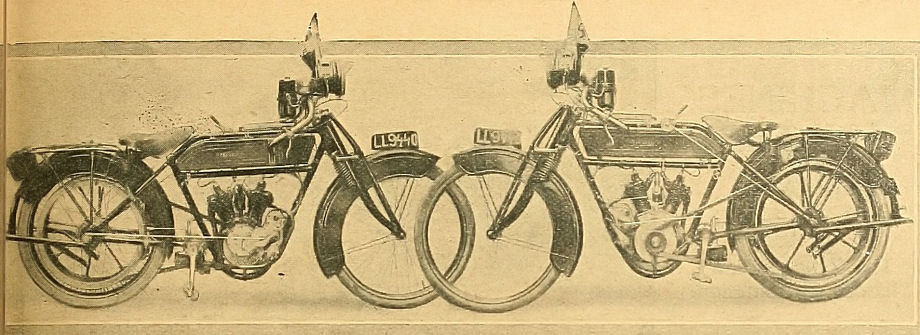


Both sides of the 2¾ h.p. twin-cylinder Peugeot, fitted with belt drive, Armstrong three-speed gear, and side-by-side valve engine.
A WELL-DESIGNED FRENCH LIGHTWEIGHT.
IT is only to be expected that any product of such a renowned and old-established firm as Peugeot should border on the exceptional; therefore, it was with this idea in our heads that we inspected and tried a lightweight model fitted with a 2¾ h.p. power unit. We were, of course, quite correct in our conjectures, for the power developed by the engine, which is a standard touring type, was really quite remarkable. Why this should be so is due to several vital attributes which give efficiency to an engine, such as large valves, short inlet pipe, and excellent workmanship.
The two cylinders are placed at an angle of 45° and have side by side valves, which are so positioned that the T-shaped inlet pipe can be placed in between the cylinders. There the Claudel carburetter is also attached, and a consequent warming up of the whole gas-making device is the result. For ignition a Bosch magneto is relied upon, and is mounted on a platform at the forward end of the engine. When riding we could not help noticing the freedom from vibration, even when the engine was turning over at high speed, which certainly shows this balancing has been carried out with great skill. Another great asset to the machine was the three-speed Armstrong gear which enabled a really high velocity on the level without stressing the engine unduly, for with three ratios the speed can always be comparatively high.
The kick starter, which is of the ordinary pedalling gear type, can be easily dispensed with, and it is quite easy to negotiate crowded thoroughfares without resorting to the clutch.
On the majority of motor cycles the handle-bar operated brake on to the front wheel is [] and it is there because the law demands its presence. In this case, however, the brake shoe works in the special pulley provided for the orthodox foot-actioned brake, and is most effective as well as being very sweet in action. The design of the silencer is most meritorious both in theory and practice, although it is quite simple, as a careful study of the illustration will reveal. In order to make the rear wheel as accessible as possible, three large wing nuts only are utilised to hold on the mudguard and carrier. Being fitted with powerful spring washers, there is very little chance of them coming adrift through vibration, and the elimination of these appendages gives one a great deal of room in carrying out tyre repairs and other adjustments.
An Advantage of Low Compression.
For starting, it was only necessary, even when cold, to peddle the machine for a few yards, and firing would commence immediately. The low compression assisted greatly in this, and rendered the use of the clutch quite unnecessary when driving in traffic. During our run on the road, many bumpy stretches were encountered, but the suspension was quite up to the average, and there is no doubt that for solo touring this little mount is bound to appeal to all who sample its running.
R. Dequin, 32, Queen Victoria Street, E.C., is handling the machine in this country.
The Motor Cycle, July 30th, 1914. p152